LINCOLN MKZ HYBRID 2013 Owners Manual
Manufacturer: LINCOLN, Model Year: 2013, Model line: MKZ HYBRID, Model: LINCOLN MKZ HYBRID 2013Pages: 475, PDF Size: 3.89 MB
Page 181 of 475
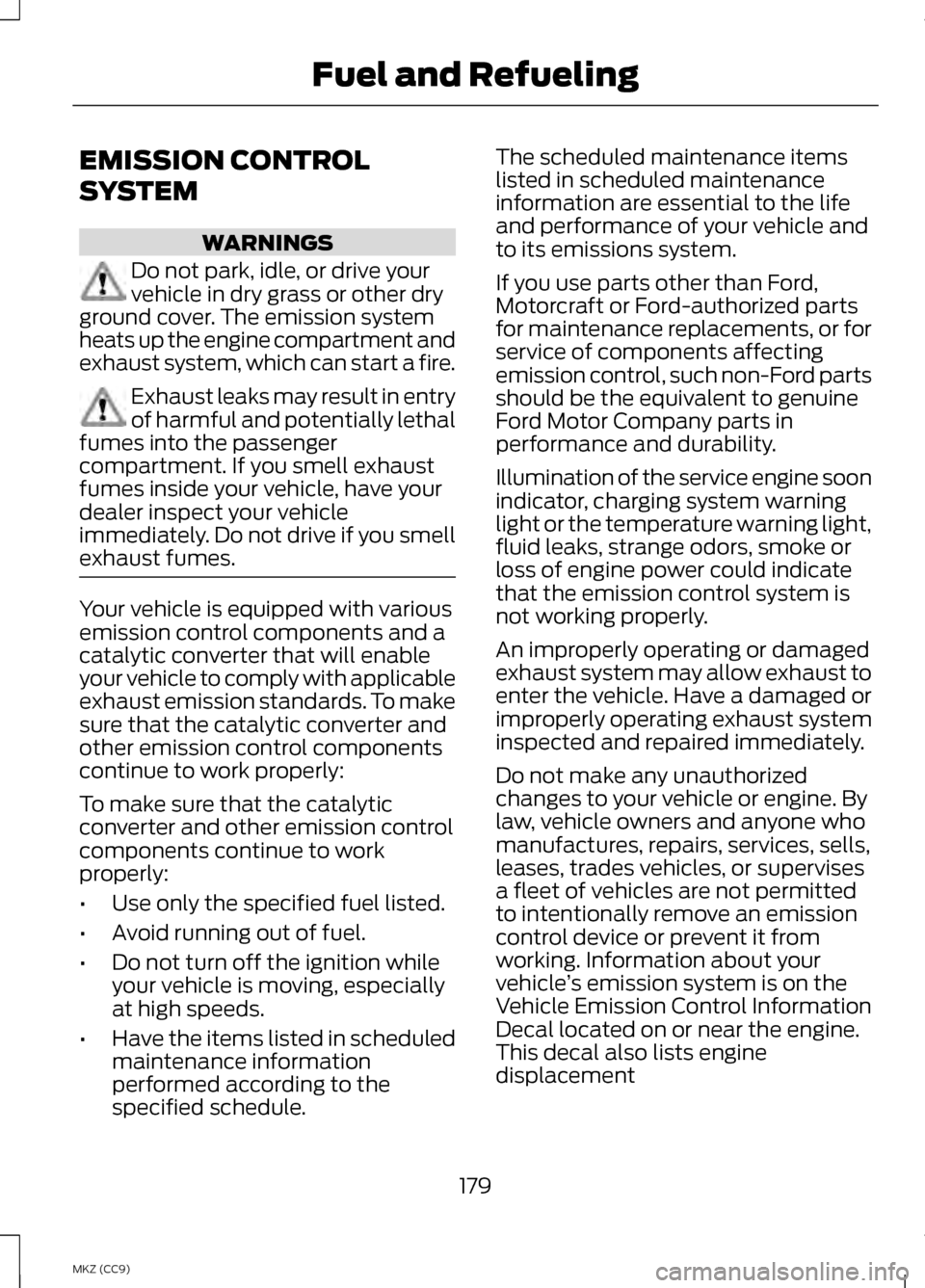
EMISSION CONTROL
SYSTEM
WARNINGS
Do not park, idle, or drive your
vehicle in dry grass or other dry
ground cover. The emission system
heats up the engine compartment and
exhaust system, which can start a fire. Exhaust leaks may result in entry
of harmful and potentially lethal
fumes into the passenger
compartment. If you smell exhaust
fumes inside your vehicle, have your
dealer inspect your vehicle
immediately. Do not drive if you smell
exhaust fumes. Your vehicle is equipped with various
emission control components and a
catalytic converter that will enable
your vehicle to comply with applicable
exhaust emission standards. To make
sure that the catalytic converter and
other emission control components
continue to work properly:
To make sure that the catalytic
converter and other emission control
components continue to work
properly:
•
Use only the specified fuel listed.
• Avoid running out of fuel.
• Do not turn off the ignition while
your vehicle is moving, especially
at high speeds.
• Have the items listed in scheduled
maintenance information
performed according to the
specified schedule. The scheduled maintenance items
listed in scheduled maintenance
information are essential to the life
and performance of your vehicle and
to its emissions system.
If you use parts other than Ford,
Motorcraft or Ford-authorized parts
for maintenance replacements, or for
service of components affecting
emission control, such non-Ford parts
should be the equivalent to genuine
Ford Motor Company parts in
performance and durability.
Illumination of the service engine soon
indicator, charging system warning
light or the temperature warning light,
fluid leaks, strange odors, smoke or
loss of engine power could indicate
that the emission control system is
not working properly.
An improperly operating or damaged
exhaust system may allow exhaust to
enter the vehicle. Have a damaged or
improperly operating exhaust system
inspected and repaired immediately.
Do not make any unauthorized
changes to your vehicle or engine. By
law, vehicle owners and anyone who
manufactures, repairs, services, sells,
leases, trades vehicles, or supervises
a fleet of vehicles are not permitted
to intentionally remove an emission
control device or prevent it from
working. Information about your
vehicle
’s emission system is on the
Vehicle Emission Control Information
Decal located on or near the engine.
This decal also lists engine
displacement
179
MKZ (CC9) Fuel and Refueling
Page 182 of 475
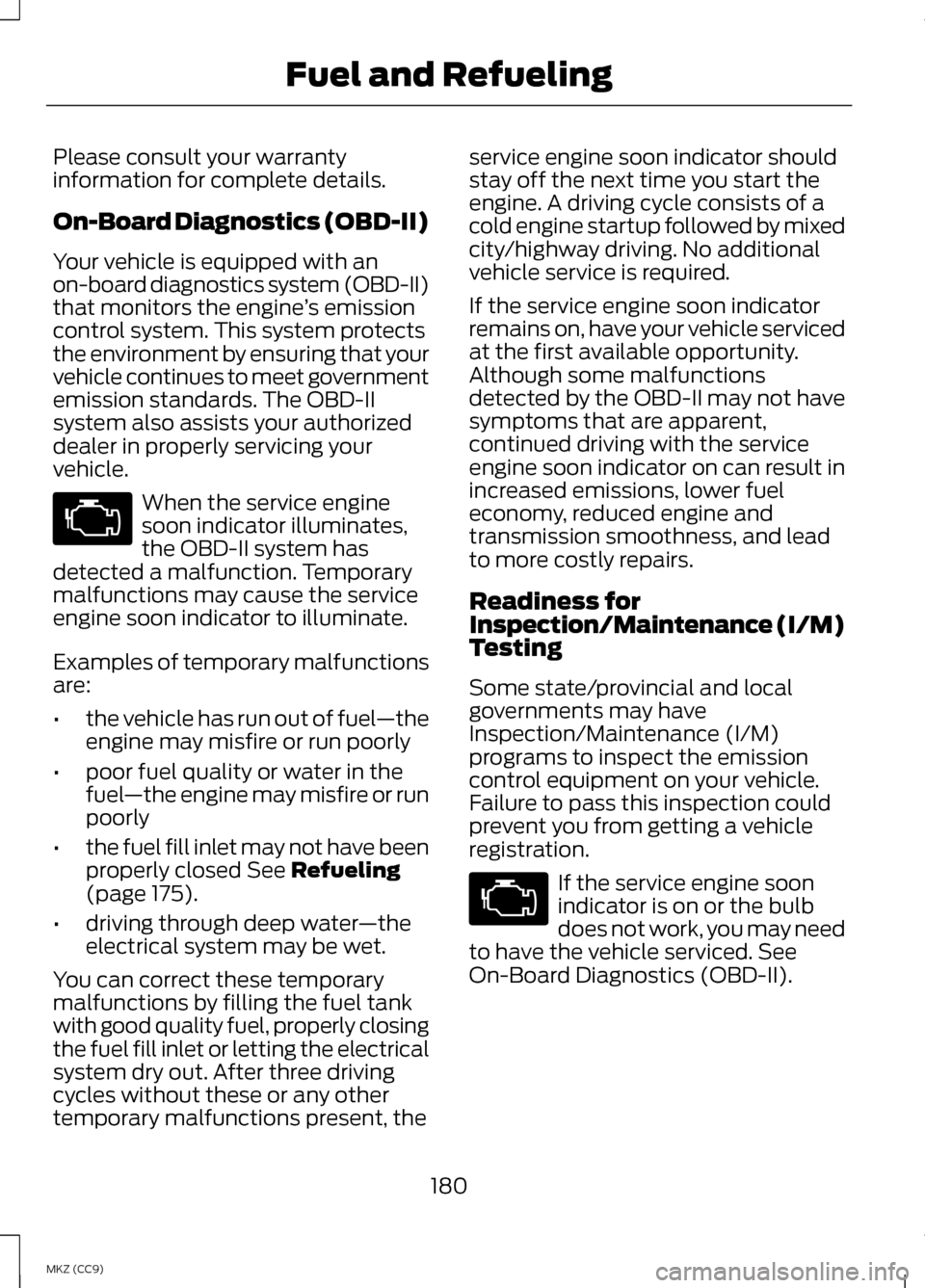
Please consult your warranty
information for complete details.
On-Board Diagnostics (OBD-II)
Your vehicle is equipped with an
on-board diagnostics system (OBD-II)
that monitors the engine
’s emission
control system. This system protects
the environment by ensuring that your
vehicle continues to meet government
emission standards. The OBD-II
system also assists your authorized
dealer in properly servicing your
vehicle. When the service engine
soon indicator illuminates,
the OBD-II system has
detected a malfunction. Temporary
malfunctions may cause the service
engine soon indicator to illuminate.
Examples of temporary malfunctions
are:
• the vehicle has run out of fuel —the
engine may misfire or run poorly
• poor fuel quality or water in the
fuel —the engine may misfire or run
poorly
• the fuel fill inlet may not have been
properly closed See Refueling
(page 175).
• driving through deep water —the
electrical system may be wet.
You can correct these temporary
malfunctions by filling the fuel tank
with good quality fuel, properly closing
the fuel fill inlet or letting the electrical
system dry out. After three driving
cycles without these or any other
temporary malfunctions present, the service engine soon indicator should
stay off the next time you start the
engine. A driving cycle consists of a
cold engine startup followed by mixed
city/highway driving. No additional
vehicle service is required.
If the service engine soon indicator
remains on, have your vehicle serviced
at the first available opportunity.
Although some malfunctions
detected by the OBD-II may not have
symptoms that are apparent,
continued driving with the service
engine soon indicator on can result in
increased emissions, lower fuel
economy, reduced engine and
transmission smoothness, and lead
to more costly repairs.
Readiness for
Inspection/Maintenance (I/M)
Testing
Some state/provincial and local
governments may have
Inspection/Maintenance (I/M)
programs to inspect the emission
control equipment on your vehicle.
Failure to pass this inspection could
prevent you from getting a vehicle
registration.
If the service engine soon
indicator is on or the bulb
does not work, you may need
to have the vehicle serviced. See
On-Board Diagnostics (OBD-II).
180
MKZ (CC9) Fuel and Refueling
Page 183 of 475
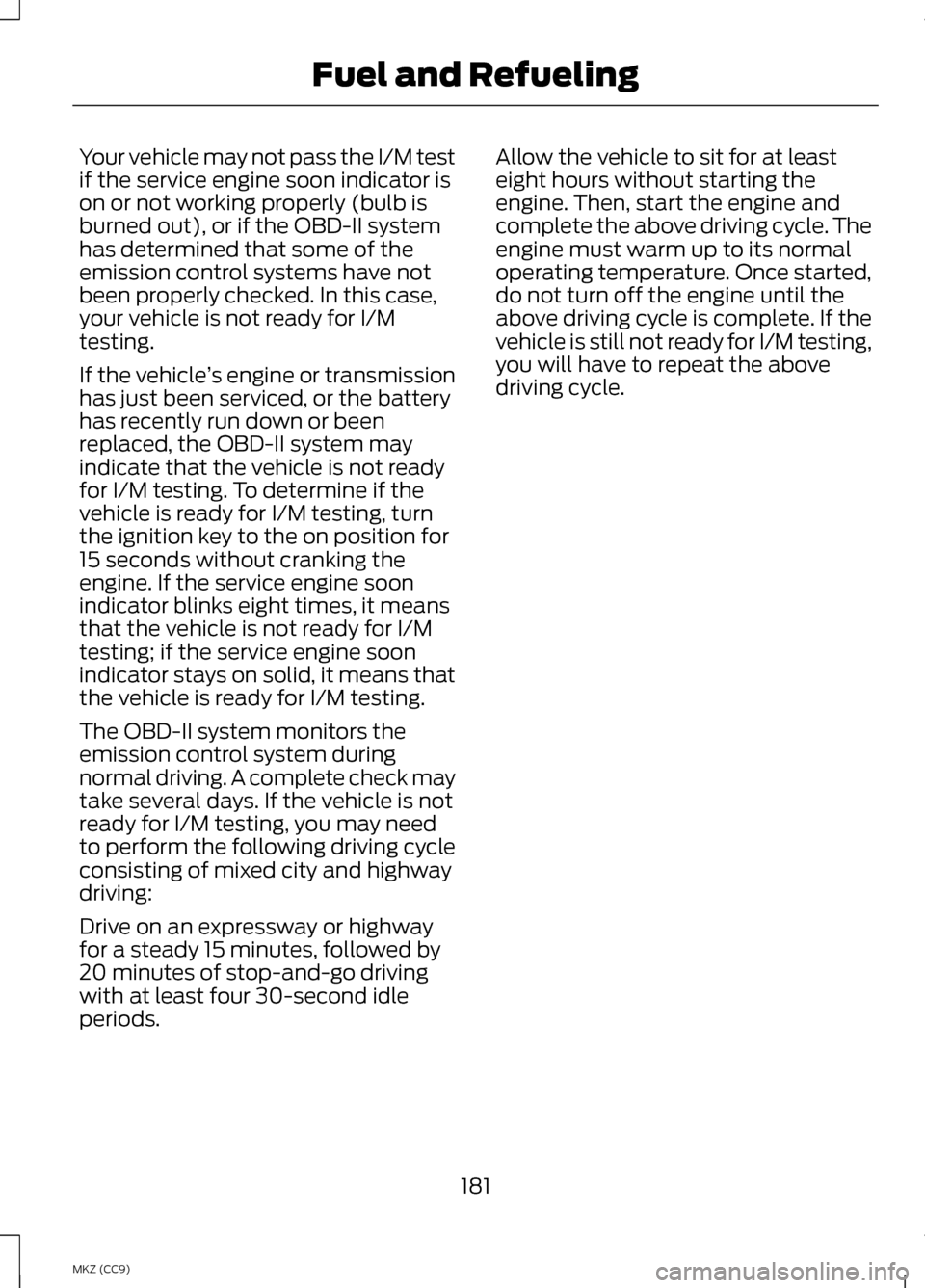
Your vehicle may not pass the I/M test
if the service engine soon indicator is
on or not working properly (bulb is
burned out), or if the OBD-II system
has determined that some of the
emission control systems have not
been properly checked. In this case,
your vehicle is not ready for I/M
testing.
If the vehicle
’s engine or transmission
has just been serviced, or the battery
has recently run down or been
replaced, the OBD-II system may
indicate that the vehicle is not ready
for I/M testing. To determine if the
vehicle is ready for I/M testing, turn
the ignition key to the on position for
15 seconds without cranking the
engine. If the service engine soon
indicator blinks eight times, it means
that the vehicle is not ready for I/M
testing; if the service engine soon
indicator stays on solid, it means that
the vehicle is ready for I/M testing.
The OBD-II system monitors the
emission control system during
normal driving. A complete check may
take several days. If the vehicle is not
ready for I/M testing, you may need
to perform the following driving cycle
consisting of mixed city and highway
driving:
Drive on an expressway or highway
for a steady 15 minutes, followed by
20 minutes of stop-and-go driving
with at least four 30-second idle
periods. Allow the vehicle to sit for at least
eight hours without starting the
engine. Then, start the engine and
complete the above driving cycle. The
engine must warm up to its normal
operating temperature. Once started,
do not turn off the engine until the
above driving cycle is complete. If the
vehicle is still not ready for I/M testing,
you will have to repeat the above
driving cycle.
181
MKZ (CC9) Fuel and Refueling
Page 184 of 475
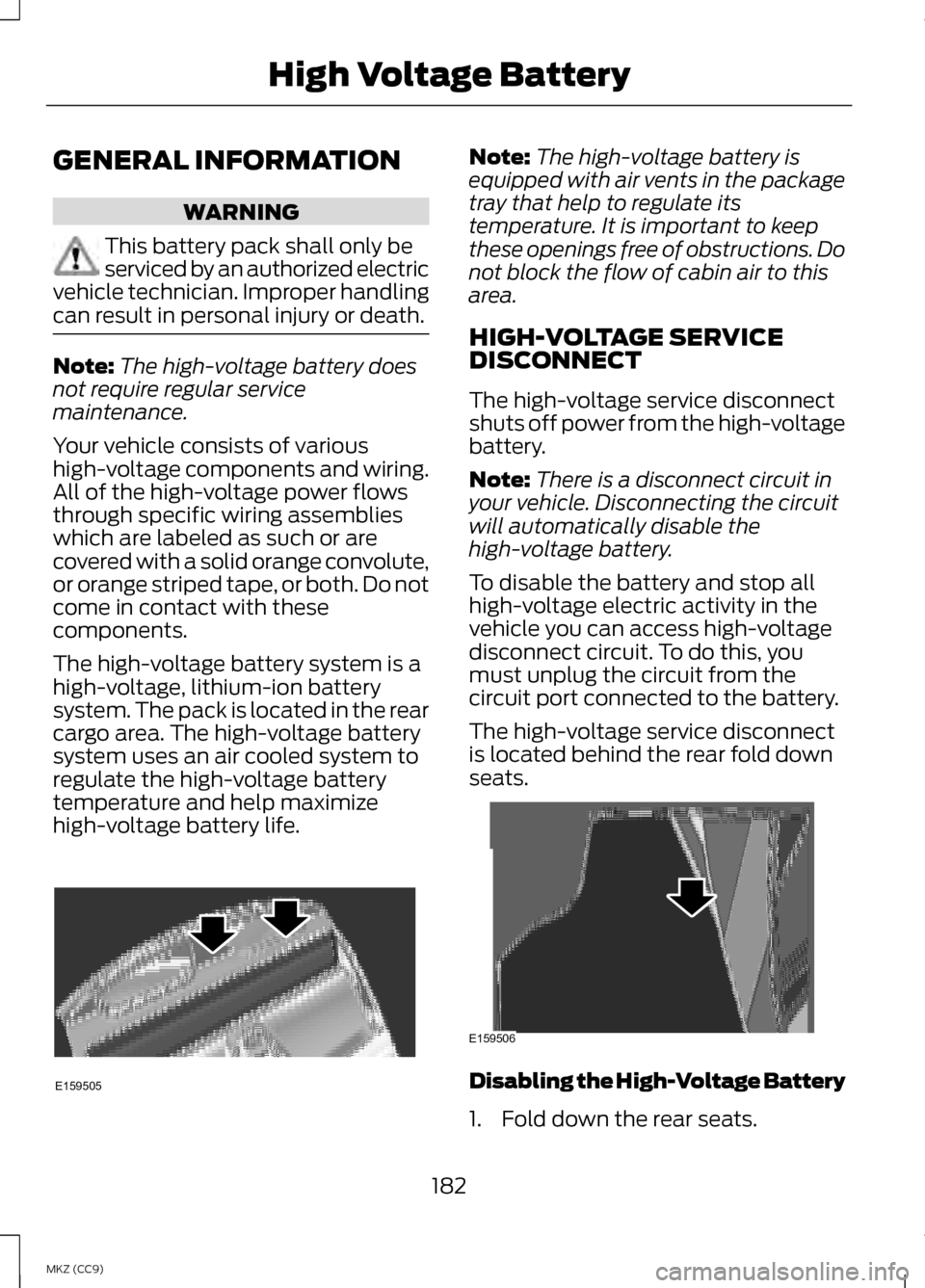
GENERAL INFORMATION
WARNING
This battery pack shall only be
serviced by an authorized electric
vehicle technician. Improper handling
can result in personal injury or death. Note:
The high-voltage battery does
not require regular service
maintenance.
Your vehicle consists of various
high-voltage components and wiring.
All of the high-voltage power flows
through specific wiring assemblies
which are labeled as such or are
covered with a solid orange convolute,
or orange striped tape, or both. Do not
come in contact with these
components.
The high-voltage battery system is a
high-voltage, lithium-ion battery
system. The pack is located in the rear
cargo area. The high-voltage battery
system uses an air cooled system to
regulate the high-voltage battery
temperature and help maximize
high-voltage battery life. Note:
The high-voltage battery is
equipped with air vents in the package
tray that help to regulate its
temperature. It is important to keep
these openings free of obstructions. Do
not block the flow of cabin air to this
area.
HIGH-VOLTAGE SERVICE
DISCONNECT
The high-voltage service disconnect
shuts off power from the high-voltage
battery.
Note: There is a disconnect circuit in
your vehicle. Disconnecting the circuit
will automatically disable the
high-voltage battery.
To disable the battery and stop all
high-voltage electric activity in the
vehicle you can access high-voltage
disconnect circuit. To do this, you
must unplug the circuit from the
circuit port connected to the battery.
The high-voltage service disconnect
is located behind the rear fold down
seats. Disabling the High-Voltage Battery
1. Fold down the rear seats.
182
MKZ (CC9) High Voltage BatteryE159505 E159506
Page 185 of 475
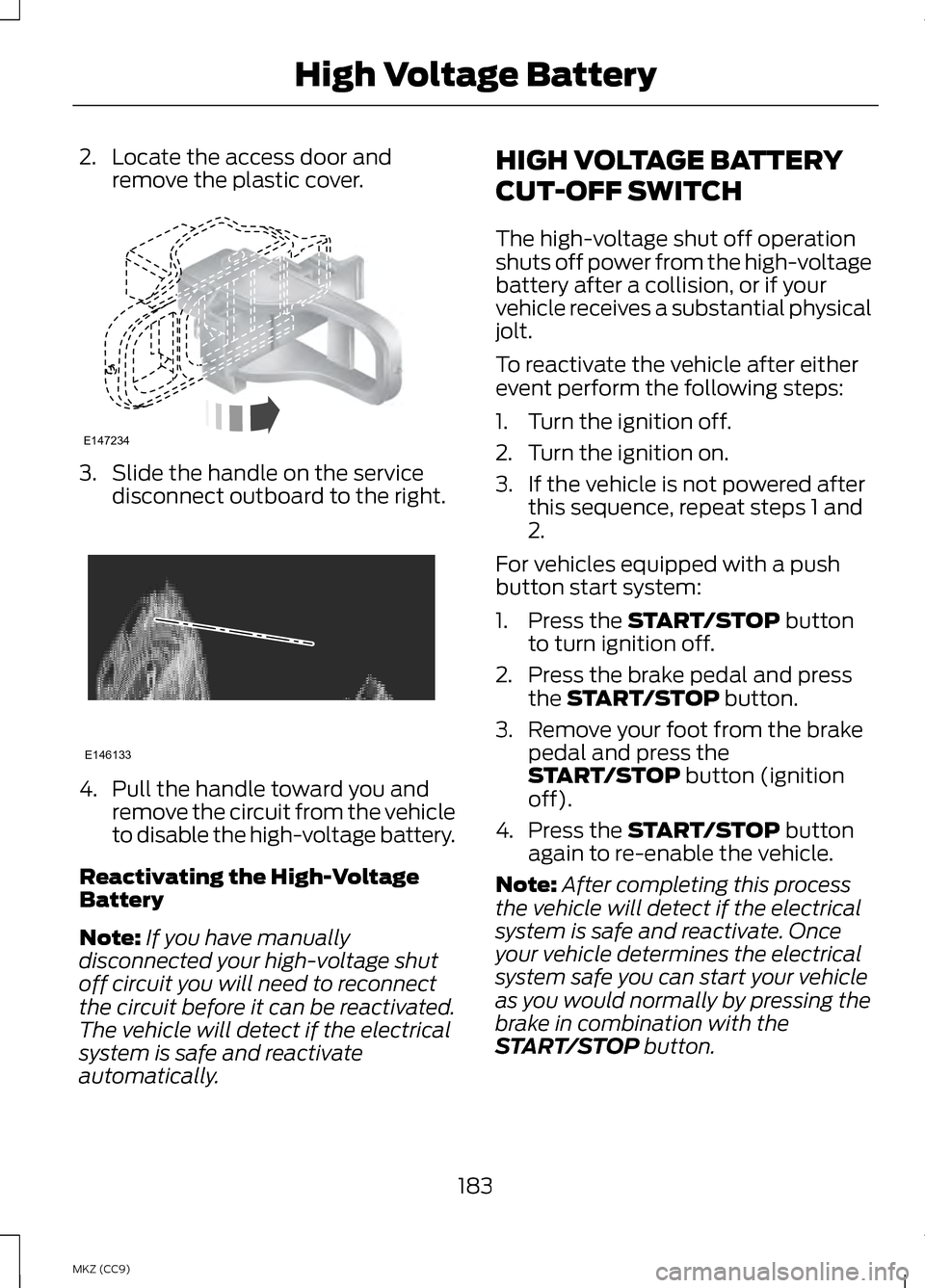
2. Locate the access door and
remove the plastic cover. 3. Slide the handle on the service
disconnect outboard to the right. 4. Pull the handle toward you and
remove the circuit from the vehicle
to disable the high-voltage battery.
Reactivating the High-Voltage
Battery
Note: If you have manually
disconnected your high-voltage shut
off circuit you will need to reconnect
the circuit before it can be reactivated.
The vehicle will detect if the electrical
system is safe and reactivate
automatically. HIGH VOLTAGE BATTERY
CUT-OFF SWITCH
The high-voltage shut off operation
shuts off power from the high-voltage
battery after a collision, or if your
vehicle receives a substantial physical
jolt.
To reactivate the vehicle after either
event perform the following steps:
1. Turn the ignition off.
2. Turn the ignition on.
3. If the vehicle is not powered after
this sequence, repeat steps 1 and
2.
For vehicles equipped with a push
button start system:
1. Press the START/STOP button
to turn ignition off.
2. Press the brake pedal and press the
START/STOP button.
3. Remove your foot from the brake pedal and press the
START/STOP
button (ignition
off).
4. Press the
START/STOP button
again to re-enable the vehicle.
Note: After completing this process
the vehicle will detect if the electrical
system is safe and reactivate. Once
your vehicle determines the electrical
system safe you can start your vehicle
as you would normally by pressing the
brake in combination with the
START/STOP
button.
183
MKZ (CC9) High Voltage BatteryE147234 E146133
Page 186 of 475
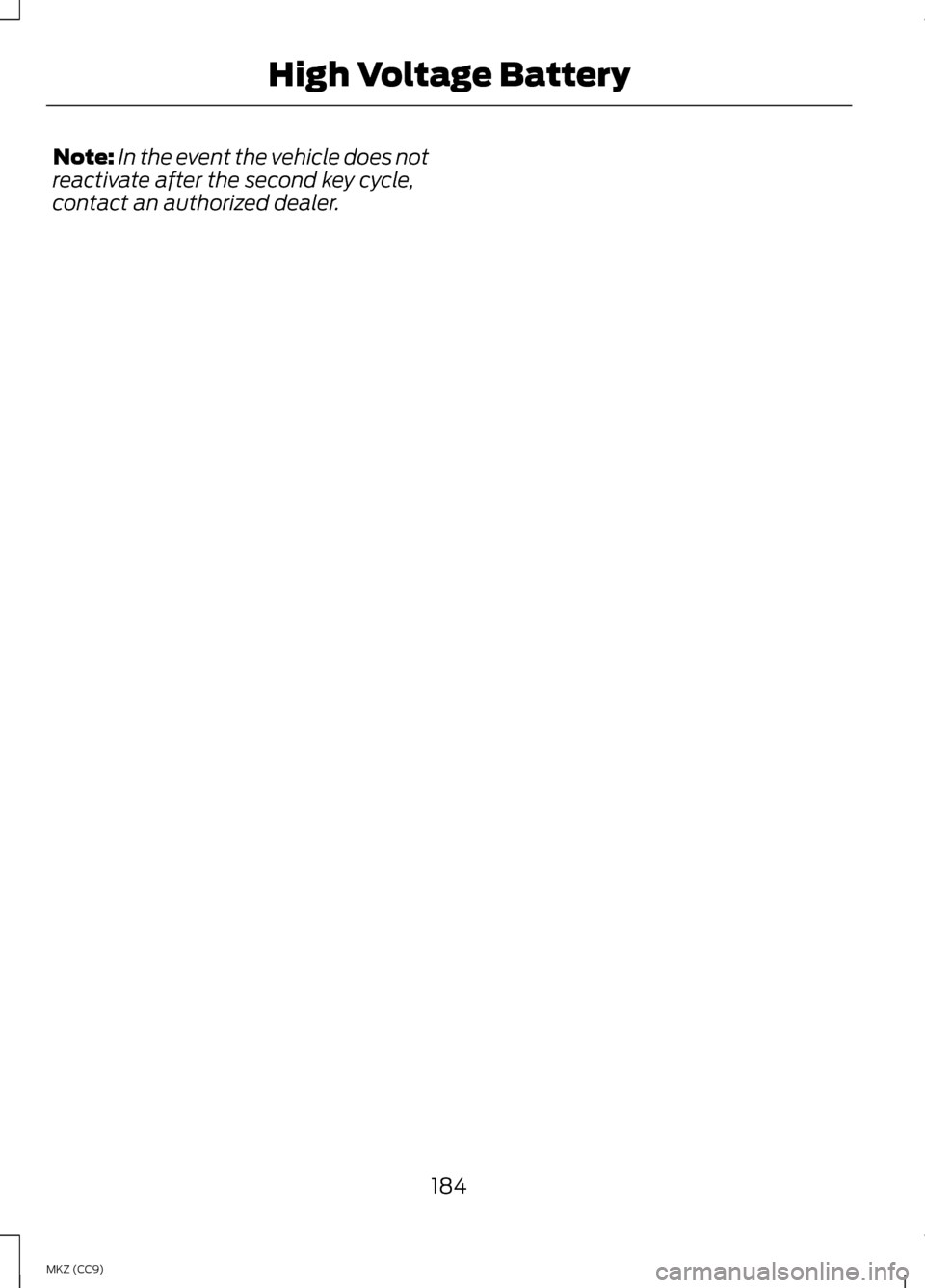
Note:
In the event the vehicle does not
reactivate after the second key cycle,
contact an authorized dealer.
184
MKZ (CC9) High Voltage Battery
Page 187 of 475
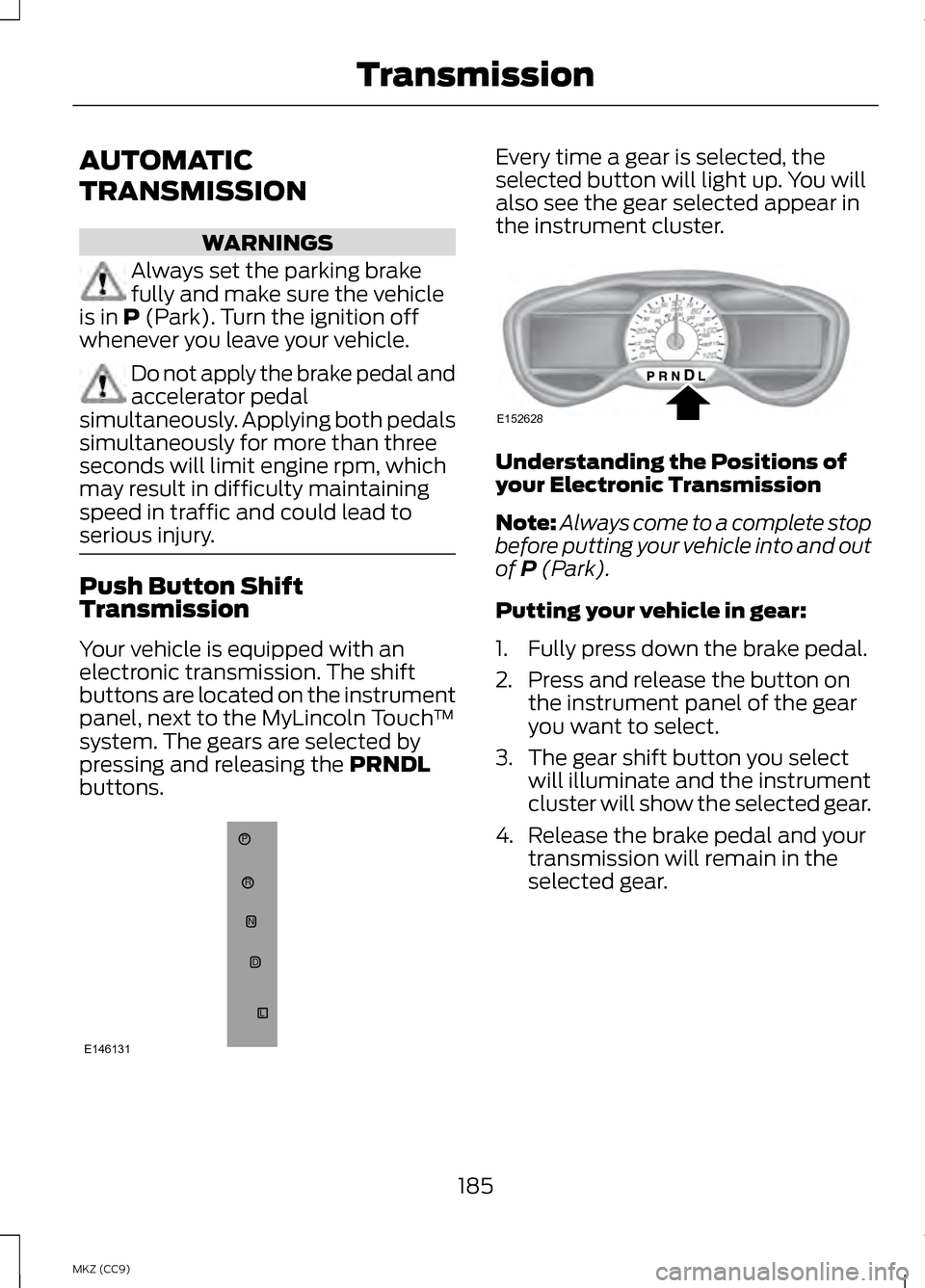
AUTOMATIC
TRANSMISSION
WARNINGS
Always set the parking brake
fully and make sure the vehicle
is in P (Park). Turn the ignition off
whenever you leave your vehicle. Do not apply the brake pedal and
accelerator pedal
simultaneously. Applying both pedals
simultaneously for more than three
seconds will limit engine rpm, which
may result in difficulty maintaining
speed in traffic and could lead to
serious injury. Push Button Shift
Transmission
Your vehicle is equipped with an
electronic transmission. The shift
buttons are located on the instrument
panel, next to the MyLincoln Touch
™
system. The gears are selected by
pressing and releasing the
PRNDL
buttons. Every time a gear is selected, the
selected button will light up. You will
also see the gear selected appear in
the instrument cluster.
Understanding the Positions of
your Electronic Transmission
Note:
Always come to a complete stop
before putting your vehicle into and out
of
P (Park).
Putting your vehicle in gear:
1. Fully press down the brake pedal.
2. Press and release the button on the instrument panel of the gear
you want to select.
3. The gear shift button you select will illuminate and the instrument
cluster will show the selected gear.
4. Release the brake pedal and your transmission will remain in the
selected gear.
185
MKZ (CC9) TransmissionP
RN
D
L
E146131 E152628
Page 188 of 475
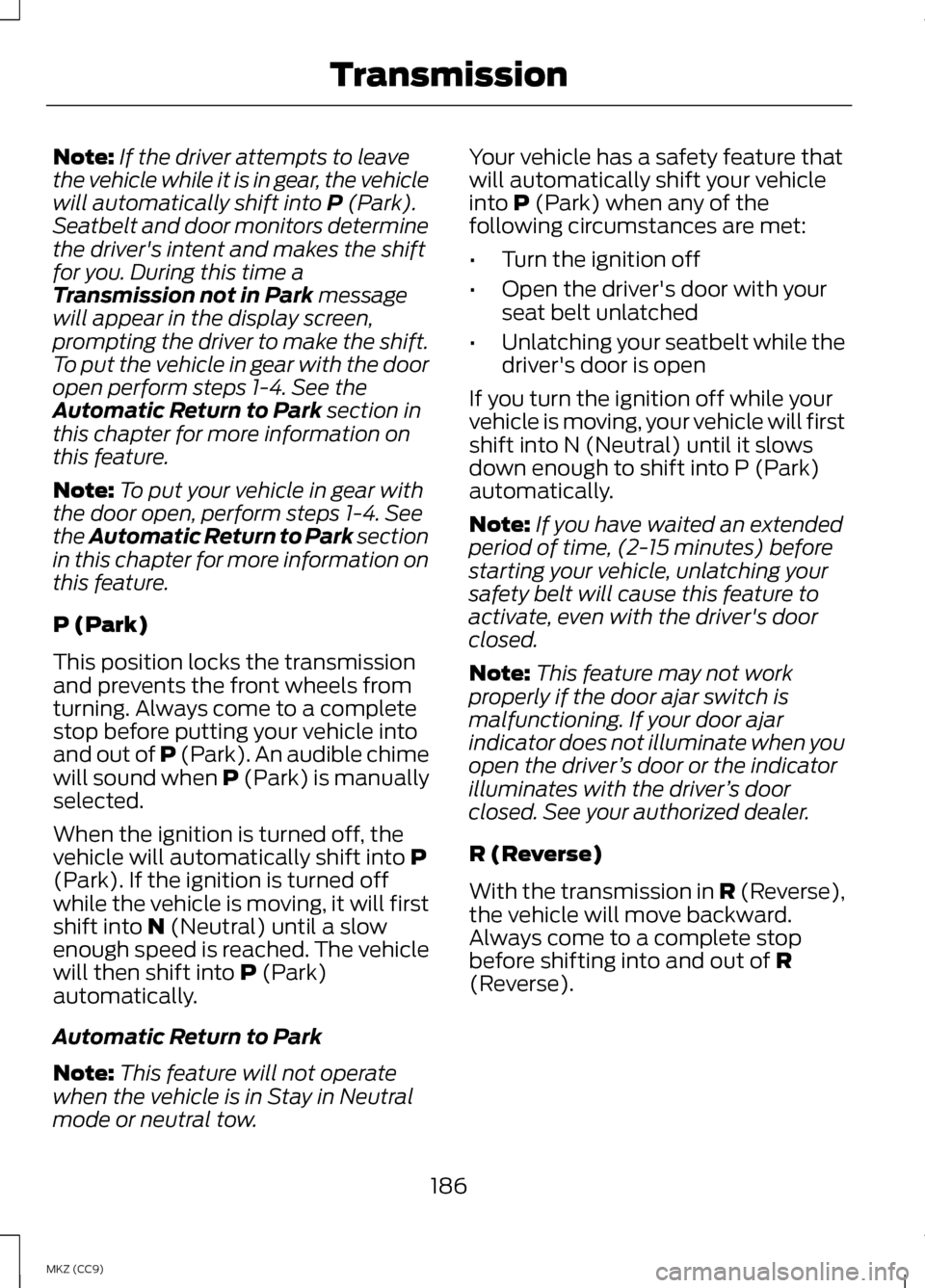
Note:
If the driver attempts to leave
the vehicle while it is in gear, the vehicle
will automatically shift into P (Park).
Seatbelt and door monitors determine
the driver's intent and makes the shift
for you. During this time a
Transmission not in Park
message
will appear in the display screen,
prompting the driver to make the shift.
To put the vehicle in gear with the door
open perform steps 1-4. See the
Automatic Return to Park
section in
this chapter for more information on
this feature.
Note: To put your vehicle in gear with
the door open, perform steps 1-4. See
the
Automatic Return to Park section
in this chapter for more information on
this feature.
P (Park)
This position locks the transmission
and prevents the front wheels from
turning. Always come to a complete
stop before putting your vehicle into
and out of P (Park). An audible chime
will sound when P (Park) is manually
selected.
When the ignition is turned off, the
vehicle will automatically shift into
P
(Park). If the ignition is turned off
while the vehicle is moving, it will first
shift into
N (Neutral) until a slow
enough speed is reached. The vehicle
will then shift into
P (Park)
automatically.
Automatic Return to Park
Note: This feature will not operate
when the vehicle is in Stay in Neutral
mode or neutral tow. Your vehicle has a safety feature that
will automatically shift your vehicle
into
P (Park) when any of the
following circumstances are met:
• Turn the ignition off
• Open the driver's door with your
seat belt unlatched
• Unlatching your seatbelt while the
driver's door is open
If you turn the ignition off while your
vehicle is moving, your vehicle will first
shift into N (Neutral) until it slows
down enough to shift into P (Park)
automatically.
Note: If you have waited an extended
period of time, (2-15 minutes) before
starting your vehicle, unlatching your
safety belt will cause this feature to
activate, even with the driver's door
closed.
Note: This feature may not work
properly if the door ajar switch is
malfunctioning. If your door ajar
indicator does not illuminate when you
open the driver ’s door or the indicator
illuminates with the driver ’s door
closed. See your authorized dealer.
R (Reverse)
With the transmission in
R (Reverse),
the vehicle will move backward.
Always come to a complete stop
before shifting into and out of
R
(Reverse).
186
MKZ (CC9) Transmission
Page 189 of 475
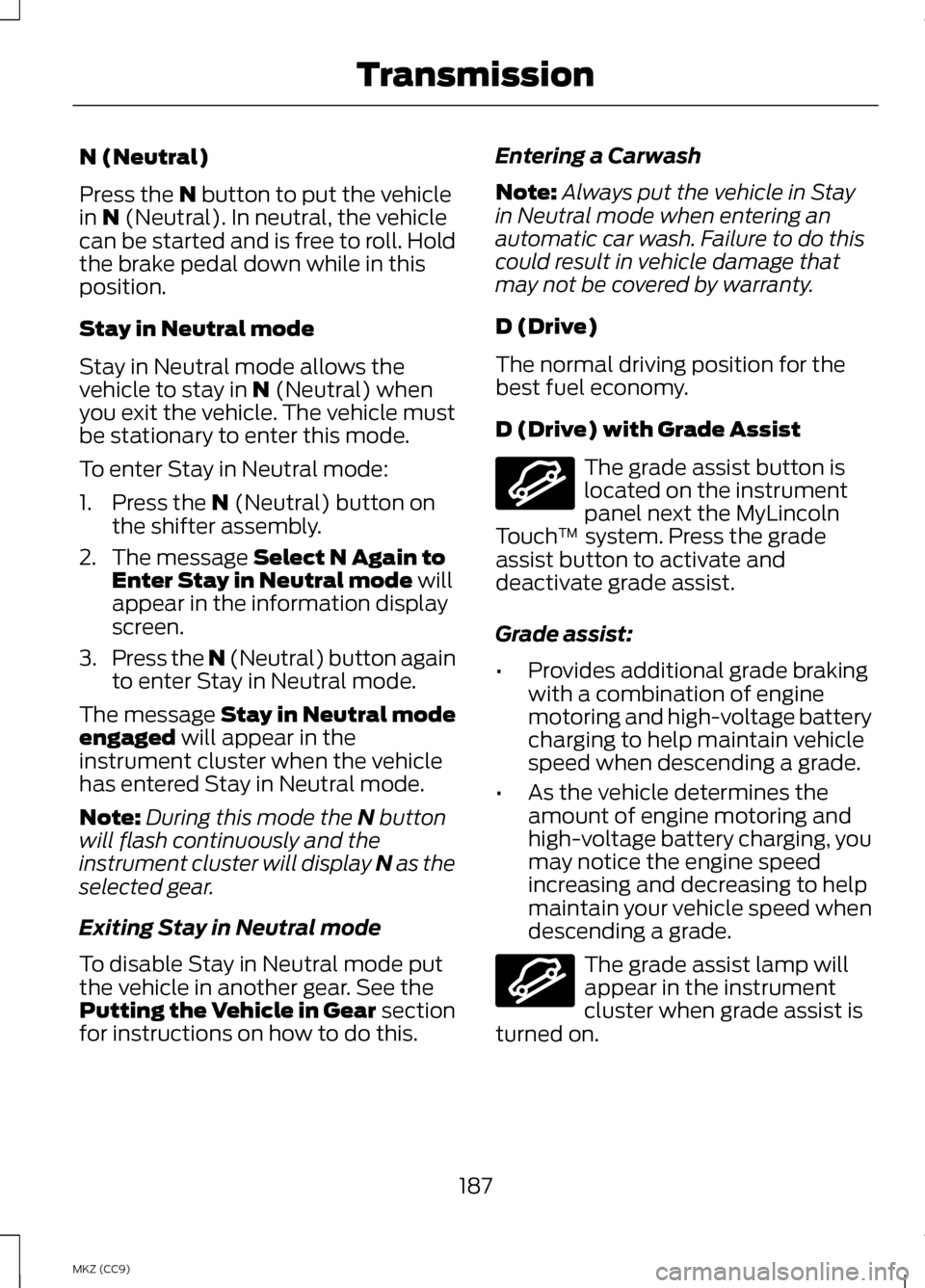
N (Neutral)
Press the N button to put the vehicle
in N (Neutral). In neutral, the vehicle
can be started and is free to roll. Hold
the brake pedal down while in this
position.
Stay in Neutral mode
Stay in Neutral mode allows the
vehicle to stay in
N (Neutral) when
you exit the vehicle. The vehicle must
be stationary to enter this mode.
To enter Stay in Neutral mode:
1. Press the
N (Neutral) button on
the shifter assembly.
2. The message
Select N Again to
Enter Stay in Neutral mode will
appear in the information display
screen.
3. Press the N (Neutral) button again
to enter Stay in Neutral mode.
The message
Stay in Neutral mode
engaged will appear in the
instrument cluster when the vehicle
has entered Stay in Neutral mode.
Note: During this mode the
N button
will flash continuously and the
instrument cluster will display N as the
selected gear.
Exiting Stay in Neutral mode
To disable Stay in Neutral mode put
the vehicle in another gear. See the
Putting the Vehicle in Gear section
for instructions on how to do this. Entering a Carwash
Note:
Always put the vehicle in Stay
in Neutral mode when entering an
automatic car wash. Failure to do this
could result in vehicle damage that
may not be covered by warranty.
D (Drive)
The normal driving position for the
best fuel economy.
D (Drive) with Grade Assist The grade assist button is
located on the instrument
panel next the MyLincoln
Touch ™ system. Press the grade
assist button to activate and
deactivate grade assist.
Grade assist:
• Provides additional grade braking
with a combination of engine
motoring and high-voltage battery
charging to help maintain vehicle
speed when descending a grade.
• As the vehicle determines the
amount of engine motoring and
high-voltage battery charging, you
may notice the engine speed
increasing and decreasing to help
maintain your vehicle speed when
descending a grade. The grade assist lamp will
appear in the instrument
cluster when grade assist is
turned on.
187
MKZ (CC9) TransmissionE144523 E144523
Page 190 of 475
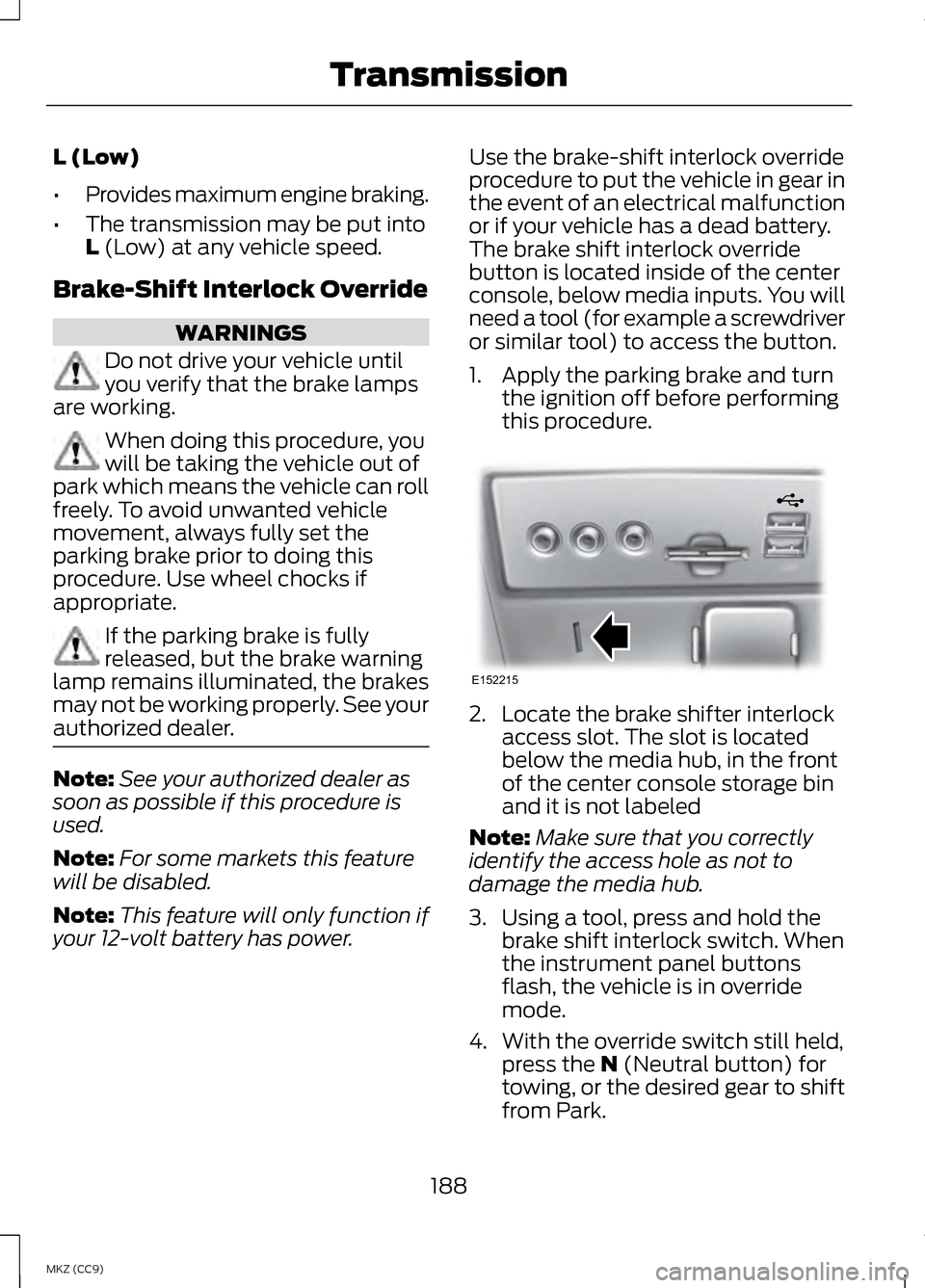
L (Low)
•
Provides maximum engine braking.
• The transmission may be put into
L (Low) at any vehicle speed.
Brake-Shift Interlock Override WARNINGS
Do not drive your vehicle until
you verify that the brake lamps
are working. When doing this procedure, you
will be taking the vehicle out of
park which means the vehicle can roll
freely. To avoid unwanted vehicle
movement, always fully set the
parking brake prior to doing this
procedure. Use wheel chocks if
appropriate. If the parking brake is fully
released, but the brake warning
lamp remains illuminated, the brakes
may not be working properly. See your
authorized dealer. Note:
See your authorized dealer as
soon as possible if this procedure is
used.
Note: For some markets this feature
will be disabled.
Note: This feature will only function if
your 12-volt battery has power. Use the brake-shift interlock override
procedure to put the vehicle in gear in
the event of an electrical malfunction
or if your vehicle has a dead battery.
The brake shift interlock override
button is located inside of the center
console, below media inputs. You will
need a tool (for example a screwdriver
or similar tool) to access the button.
1. Apply the parking brake and turn
the ignition off before performing
this procedure. 2. Locate the brake shifter interlock
access slot. The slot is located
below the media hub, in the front
of the center console storage bin
and it is not labeled
Note: Make sure that you correctly
identify the access hole as not to
damage the media hub.
3. Using a tool, press and hold the brake shift interlock switch. When
the instrument panel buttons
flash, the vehicle is in override
mode.
4. With the override switch still held, press the
N (Neutral button) for
towing, or the desired gear to shift
from Park.
188
MKZ (CC9) TransmissionE152215